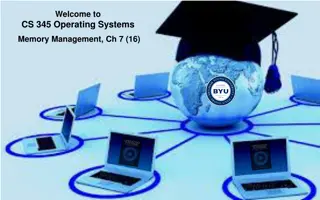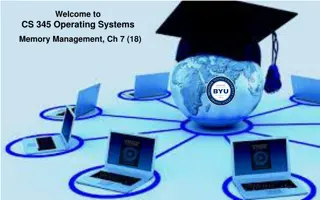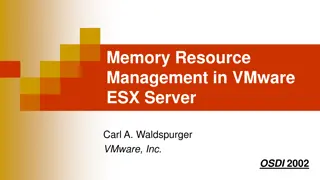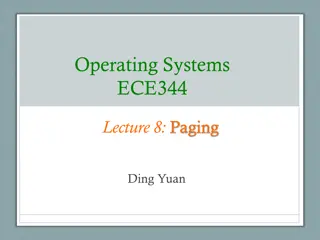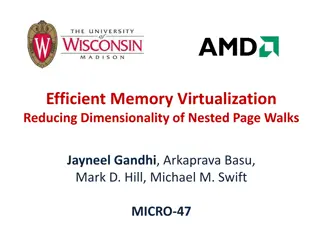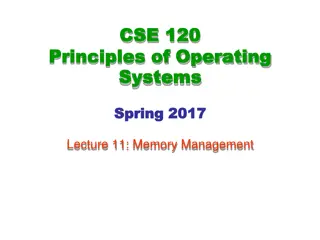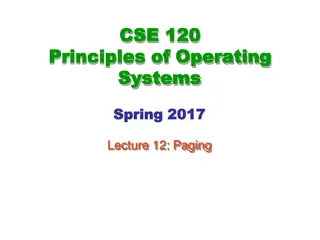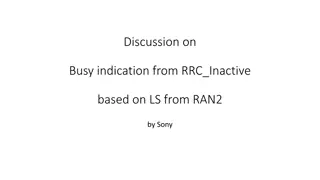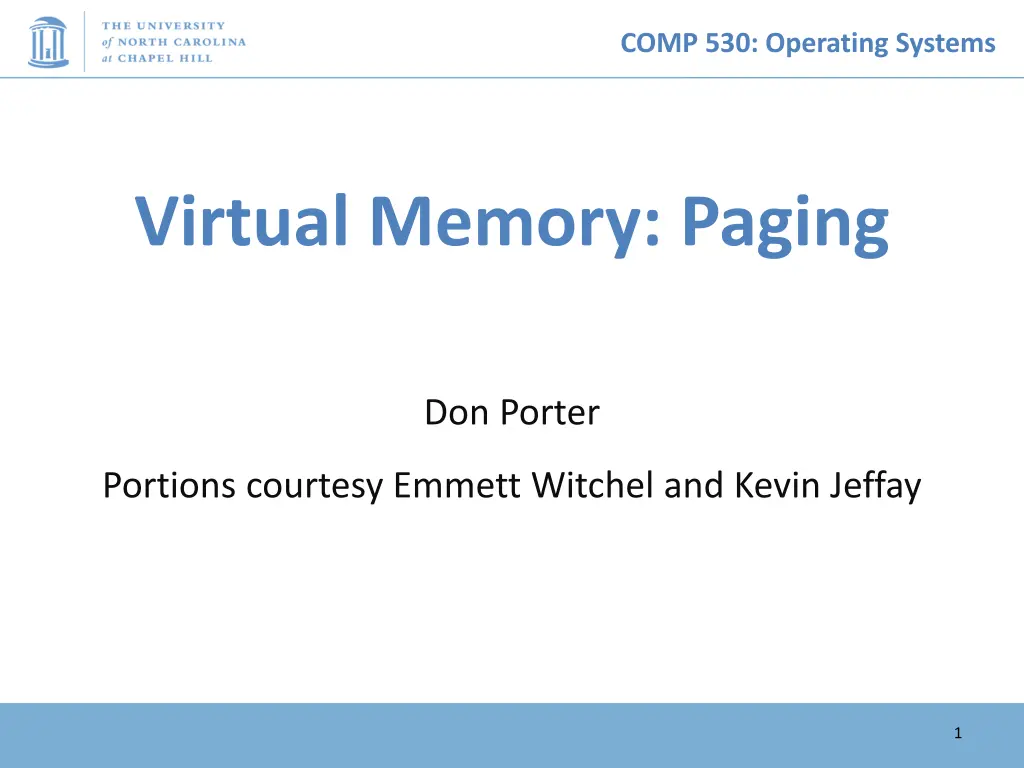
Operating Systems Paging and Virtual Memory
Explore the concepts of virtual memory, paging, and memory management in operating systems. Learn about the challenges of addressing memory limitations and the solutions provided by paging, page mapping, and physical address decomposition.
Download Presentation

Please find below an Image/Link to download the presentation.
The content on the website is provided AS IS for your information and personal use only. It may not be sold, licensed, or shared on other websites without obtaining consent from the author. If you encounter any issues during the download, it is possible that the publisher has removed the file from their server.
You are allowed to download the files provided on this website for personal or commercial use, subject to the condition that they are used lawfully. All files are the property of their respective owners.
The content on the website is provided AS IS for your information and personal use only. It may not be sold, licensed, or shared on other websites without obtaining consent from the author.
E N D
Presentation Transcript
COMP 530: Operating Systems Virtual Memory: Paging Don Porter Portions courtesy Emmett Witchel and Kevin Jeffay 1
COMP 530: Operating Systems Review Program addresses are virtual addresses. Relative offset of program regions can not change during program execution. E.g., heap can not move further from code. (Virtual address == physical address) is inconvenient. Program location is compiled into the program. Segmentation: Simple: two registers (base, offset) sufficient Limited: Virtual address space must be <= physical Push complexity to space management: Must allocate physically contiguous region for segments Must deal with external fragmentation Swapping only at segment granularity Key idea for today: Fixed size units (pages) for translation More complex mapping structure Less complex space management
COMP 530: Operating Systems Virtual Memory 2n-1 Key problem: How can one support programs that require more memory than is physically available? How can we support programs that do not use all of their memory at once? Hide physical size of memory from users Memory is a large virtual address space of 2n bytes Only portions of VAS are in physical memory at any one time (increase memory utilization). Program P s VAS Issues Placement strategies Where to place programs in physical memory Replacement strategies What to do when there exist more processes than can fit in memory Load control strategies Determining how many processes can be in memory at one time 0
COMP 530: Operating Systems Solution: Paging (fMAX-1,oMAX-1) Physical memory partitioned into equal sized page frames Example page size: 4KB Memory only allocated in page frame sized increments No external fragmentation Can have internal fragmentation (rounding up smaller allocations to 1 page) Can map any page-aligned virtual address to a physical page frame (f,o) o Physical Memory f (0,0)
COMP 530: Operating Systems Page Mapping (fMAX-1,oMAX-1) Abstraction: 1:1 mapping of page-aligned virtual addresses to physical frames Imagine a big ole table (BOT): The size of memory / the size of a page frame Address translation is a 2-step process 1. Map virtual page onto physical frame (using BOT) 2. Add offset within the page (f,o) o Physical Memory f (0,0)
COMP 530: Operating Systems Physical Address Decomposition (fMAX-1,oMAX-1) A physical address can be split into a pair (f, o) f frame number (fmax frames) o frame offset (omax bytes/frames) Physical address = omax f + o (f,o) o PA: 1 log2 (fmax omax) Physical Memory log2omax f o f As long as a frame size is a power of 2, easy to split address using bitwise shift operations Prepare for lots of power-of-2 arithmetic (0,0)
COMP 530: Operating Systems Physical Addressing Example Suppose a 16-bit address space with (omax =) 512 byte page frames Reminder: 512 == 29 Address 1,542 can be translated to: Frame: 1,542 / 512 == 1,542 >> 9 = 3 Offset: 1,542 % 512 == 1,542 & (512-1) == 6 More simply: (3,6) (3,6) 1,542 o Physical Memory 3 6 f 0 0 0 0 0 1 1 0 0 0 0 0 0 1 1 0 1 PA: 16 10 9 1,542 (0,0) 0
COMP 530: Operating Systems Virtual Page Addresses 2n-1 = A process s virtual address space is partitioned into equal sized pages page = page frame (pMAX-1,oMAX-1) (p,o) o A virtual address is a pair (p, o) p page number (pmax pages) o page offset (omax bytes/pages) Virtual address = omax p + o Virtual Address Space p VA: 1 log2 (pmax omax) log2 oMAX p o (0,0)
COMP 530: Operating Systems Page mapping Pages map to frames Pages are contiguous in a VAS... But pages are arbitrarily located in physical memory, and Not all pages mapped at all times Virtual Address Space (f1,o1) Physical Memory (p2,o2) (p1,o1) (f2,o2)
COMP 530: Operating Systems Questions The offset is the same in a virtual address and a physical address. A. True B. False
COMP 530: Operating Systems Page Tables (aka Big Ole Table) A page table maps virtual pages to physical frames Program P (f,o) CPU P s Virtual Address Space p o f o Physical Memory 20 10 9 1 16 10 9 1 Virtual Addresses Physical Addresses (p,o) f p Page Table
COMP 530: Operating Systems Page Table Details 1 table per process Part of process metadata/state Contents: Flags dirty bit, resident bit, clock/reference bit Frame number CPU p o f o 20 10 9 1 16 10 9 1 Virtual Addresses Physical Addresses f + PTBR 0 10 p Page Table
COMP 530: Operating Systems Example (4,1023) A system with 16-bit addresses 32 KB of physical memory 1024 byte pages (4,0) (3,1023) CPU Physical Addresses P s Virtual Address Space p o f o Physical Memory 109 9 15 0 14 0 10 Virtual Addresses Flags|Phys. Addr 1 0 0 0 0 0 0 0 0 0 1 0 0 1 0 0 (0,0) Page Table
COMP 530: Operating Systems Performance Issues with Paging Problem VM reference requires 2 memory references! One access to get the page table entry One access to get the data Page table can be very large; a part of the page table can be on disk. For a machine with 64-bit addresses and 1024 byte pages, what is the size of a page table? What to do? Most computing problems are solved by some form of Caching Indirection
COMP 530: Operating Systems Using a TLB to Cache Translations Cache recently accessed page-to-frame translations in a TLB For TLB hit, physical page number obtained in 1 cycle For TLB miss, translation is updated in TLB Has high hit ratio (why?) f o Physical Addresses CPU 16 10 9 1 p o Virtual Addresses ? 20 10 9 1 Key Value p f f TLB p X Page Table
COMP 530: Operating Systems Dealing with Large Tables Add additional levels of indirection to the page table by sub-dividing page number into k parts Create a tree of page tables TLB still used, just not shown The architecture determines the number of levels of page table Second-Level Page Tables Virtual Address p2 p1 p2 p3 o p3 p1 Third-Level Page Tables First-Level Page Table
COMP 530: Operating Systems Dealing with Large Tables Example: Two-level paging CPU Memory p1 p2 o f o Virtual Addresses Physical Addresses 20 16 10 1 16 10 1 + + PTBR f page table p1 p2 First-Level Page Table Second-Level Page Table
COMP 530: Operating Systems Large Virtual Address Spaces With large address spaces (64-bits) forward mapped page tables become cumbersome. E.g. 5 levels of tables. Instead of making tables proportional to size of virtual address space, make them proportional to the size of physical address space. Virtual address space is growing faster than physical. Use one entry for each physical page with a hash table Translation table occupies a very small fraction of physical memory Size of translation table is independent of VM size Page table has 1 entry per virtual page Hashed/Inverted page table has 1 entry per physical frame
COMP 530: Operating Systems Frames and pages Only mapping virtual pages that are in use does what? A. Increases memory utilization. B. Increases performance for user applications. C. Allows an OS to run more programs concurrently. D. Gives the OS freedom to move virtual pages in the virtual address space. Address translation and changing address mappings are A. Frequent and frequent B. Frequent and infrequent C. Infrequent and frequent D. Infrequent and infrequent
COMP 530: Operating Systems Hashed/Inverted Page Tables Each frame is associated with a register containing Residence bit: whether or not the frame is occupied Occupier: page number of the page occupying frame Protection bits Page registers: an example Physical memory size: 16 MB Page size: 4096 bytes Number of frames: 4096 Space used for page registers (assuming 8 bytes/register): 32 Kbytes Percentage overhead introduced by page registers: 0.2% Size of virtual memory: irrelevant
COMP 530: Operating Systems Inverted Page Table Lookup CPU generates virtual addresses, where is the physical page? Hash the virtual address Must deal with conflicts TLB caches recent translations, so page lookup can take several steps Hash the address Check the tag of the entry Possibly rehash/traverse list of conflicting entries TLB is limited in size Difficult to make large and accessible in a single cycle. They consume a lot of power (27% of on-chip for StrongARM)
COMP 530: Operating Systems Inverted Page Table Lookup Hash page numbers to find corresponding frame number Page frame number is not explicitly stored (1 frame per entry) Protection, dirty, used, resident bits also in entry Memory CPU Virtual Address PID p o f o Physical Addresses running 9 1 16 9 1 20 tag check =? =? Hash fmax 1 fmax 2 + PTBR 1 Virt page# 0 1 PID h(PID, p) 0 Inverted Page Table
COMP 530: Operating Systems Searching Inverted Page Tables Page registers are placed in an array Page i is placed in slot f(i) where f is an agreed- upon hash function To lookup page i, perform the following: Compute f(i) and use it as an index into the table of page registers Extract the corresponding page register Check if the register tag contains i, if so, we have a hit Otherwise, we have a miss
COMP 530: Operating Systems Searching Inverted Page Tables Minor complication Since the number of pages is usually larger than the number of slots in a hash table, two or more items may hash to the same location Two different entries that map to same location are said to collide Many standard techniques for dealing with collisions Use a linked list of items that hash to a particular table entry Rehash index until the key is found or an empty table entry is reached (open hashing)
COMP 530: Operating Systems Observation One cool feature of inverted page tables is that you only need one for the entire OS Recall: each entry stores PID and virtual address Multiple processes can share one inverted table Forward mapped tables have one table per process 25
COMP 530: Operating Systems Questions Why use hashed/inverted page tables? A. Forward mapped page tables are too slow. B. Forward mapped page tables don t scale to larger virtual address spaces. C. Inverted pages tables have a simpler lookup algorithm, so the hardware that implements them is simpler. D. Inverted page tables allow a virtual page to be anywhere in physical memory.
COMP 530: Operating Systems Swapping Code A process s VAS is its context Contains its code, data, and stack Data Stack Code pages are stored in a user s file on disk Some are currently residing in memory; most are not Data and stack pages are also stored in a file Although this file is typically not visible to users File only exists while a program is executing File System (Disk) OS determines which portions of a process s VAS are mapped in memory at any one time OS/MMU Physical Memory
COMP 530: Operating Systems Physical Memory Page Fault Handling References to non-mapped pages generate a page fault Remember Interrupts? CPU Page fault handling steps: Processor runs the interrupt handler OS blocks the running process OS starts read of the unmapped page 0 Page Table OS resumes/initiates some other process Read of page completes OS maps the missing page into memory OS restart the faulting process Program P s VAS Disk
COMP 530: Operating Systems Performance Analysis To understand the overhead of swapping, compute the effective memory access time (EAT) EAT=memory access time probability of a page hit+ page fault service time probability of a page fault Example: Memory access time: 60 ns Disk access time: 25 ms Let p = the probability of a page fault EAT= 60(1 p)+ 25,000,000p To realize an EAT within 5% of minimum, what is the largest value of p we can tolerate?
COMP 530: Operating Systems Segmentation vs. Paging Segmentation has what advantages over paging? A. Fine-grained protection. B. Easier to manage transfer of segments to/from the disk. C. Requires less hardware support D. No external fragmentation Paging has what advantages over segmentation? A. Fine-grained protection. B. Easier to manage transfer of pages to/from the disk. C. Requires less hardware support. D. No external fragmentation.
COMP 530: Operating Systems Meta-Commentary Paging is really efficient when memory is relatively scarce But comes with higher latency, higher management costs in hardware and software But DRAM is getting more abundant! Push for larger page granularity (fewer levels of page tables) Or just go back to segmentation?? If everything fits into memory with space to spare, why not? 31
COMP 530: Operating Systems Summary Physical and virtual memory partitioned into equal size units Size of VAS unrelated to size of physical memory Virtual pages are mapped to physical frames Simple placement strategy There is no external fragmentation Key to good performance is minimizing page faults


